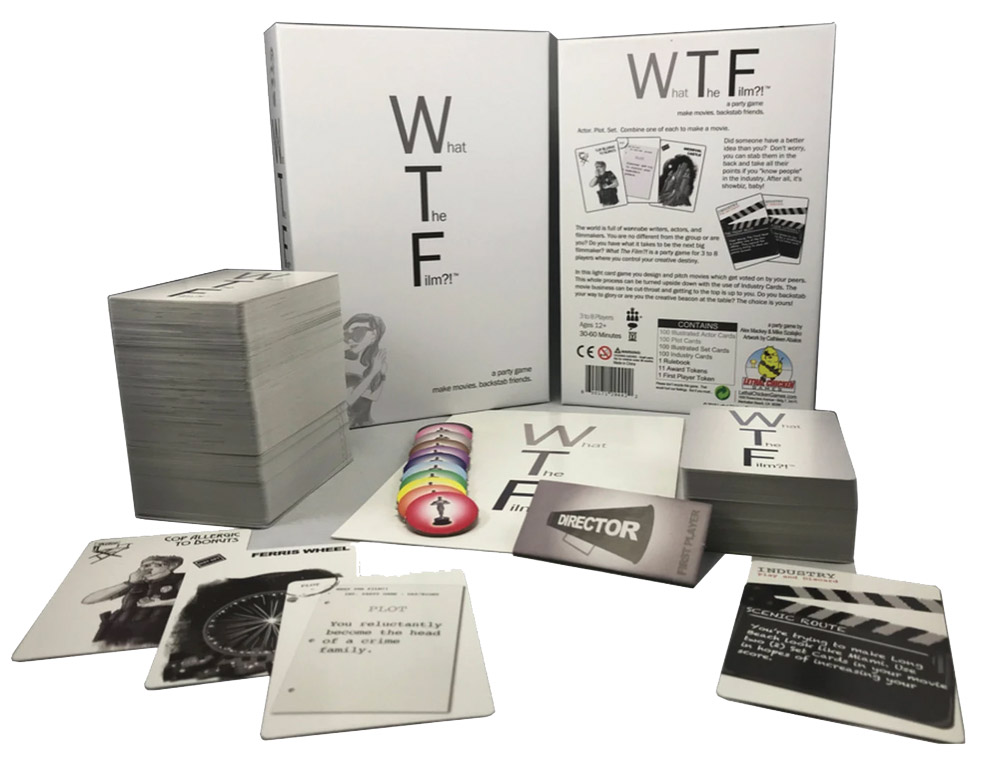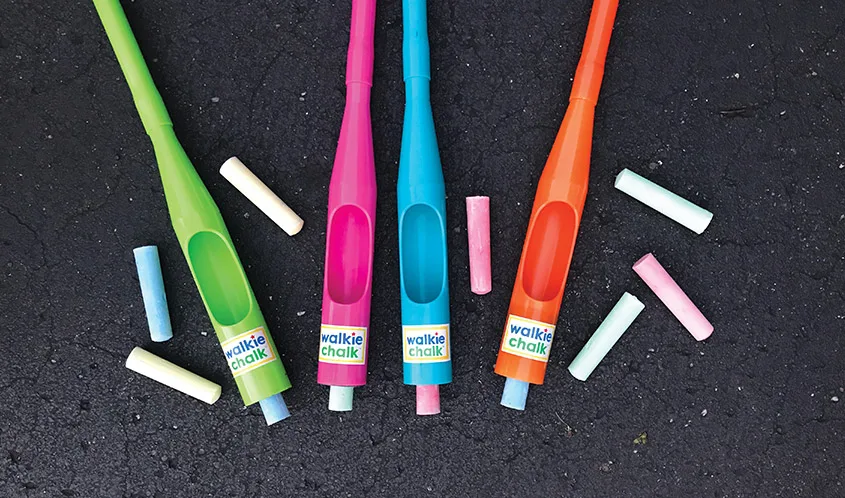Alex Mackey wasn’t planning on starting a game company.
Back in September 2017, he was volunteering for Hurricane Irma cleanup in Fort Myers, Florida, where he shared a tent with a man named Mike Szalajko. The two couldn’t sleep one night and began chatting about their shared interests: games and movies. By the early morning hours, they had invented their first game, What The Film?!
Now, more than two years later, the duo founded a company called Lethal Chicken Games (LCG), earned a Toy of the Year award nomination, and developed a second card game, Camping with Sasquach. What The Film?! is also on shelves at Target, a goal Mackey achieved by cold-emailing an employee he found on LinkedIn.
Mackey’s path isn’t exactly a typical one toy inventors take. But then again, there is no such thing as a “typical” path when it comes to toy inventing. There are endless possibilities for transforming a toy idea from a dream into a reality, but there are some common steps and opportunities for aspiring inventors.
Let’s Get It [Kick]Started
Kickstarter, a site inventors can use to obtain crowdsourced funding for a project or product, first launched back in 2009. It is a popular starting point for toy inventors who use the site to get the funding they need to start production.
While Kickstarter doesn’t have a specific “toys” category, the site’s self-published data lists games as the category with the highest dollar amount pledged — more than $1 billion in total. The category also has the highest number of campaigns that have raised more than $1 million.
As their first step, Mackey and Szalajko put What The Film?! on Kickstarter and ran a campaign for about 35 days. Despite returning to Kickstarter for LCG’s second and upcoming third games, Mackey advises caution when using the platform: Remember to take shipping and other fees into consideration when setting goals, and make the product price high enough to cover costs.
“If you’re not careful, you’re going to get eaten alive [on Kickstarter],” he says. “And that happened to us both times. Our numbers just weren’t quite high enough.”
Matthew Damman, the co-creator of Walkie Chalk — a tool that kids and parents can use to draw with chalk while standing up — also launched his product on the site.
He says the campaign went well, but it didn’t pick up as much traction as he’d hoped. He later learned this is because he limited his campaign to the U.S. due to toy testing regulations. “Kickstarter really didn’t like that,” he says. “They want global projects.”
A major upside of using Kickstarter for Damman was the resulting media attention. “It did kind of give us a platform to get it out there,” he says. “People saw it, some media contacted us, it gave me something to reference.”
Stay Small or Go Big?
After a successful or semi-successful start, toy inventors have to choose whether to become a new company or become part of an established toy company.
Mackey and Szalajko chose the former, while Damman and his wife, Shauna, chose the latter. After finding a production company and getting Walkie Chalk placed in multiple retailers, the Dammans decided to lease Walkie Chalk to PlayMonster for three years, starting last February.
When deciding between keeping, leasing, or selling your idea, Damman says the best path will vary based on what you want out of the experience.
“I would say if somebody’s very curious about how to build the product, how to bring it to market themselves, and really want to learn and figure it out, you can do it,” he says. “If they’re more an idea person that’s like, ‘Hey, I have this idea, but I don’t have the time, energy, or money to build it,’ pitching toy companies on the license is certainly a good route.”
Relinquishing complete control of your idea can be a challenge, though, which is why Mackey says LCG (so far) hasn’t pitched its products to larger companies.
“It’s like selling your child,” he says. “You just get so attached to your own ideas, your own IPs, and your own game that you’re like, ‘Ugh, I just don’t want to turn it over to someone else.’ I think with any designer there’s probably a bit of that, or maybe a fair amount.”

Pitch Perfect
The idea of starting a new toy company may sound daunting, but pitching a toy idea to an established manufacturer presents its own set of challenges. Newcomers may have trouble reaching larger companies, which are likely receiving hundreds of other pitches.
James Martin, senior vice president of robotics at Spin Master, says the company has entire teams, such as the internal advanced concepts team, dedicated to looking for new toy ideas.
Some of the company’s major lines, such as Air Hogs, Bakugan, and Moon Sand, came from outside inventors. The company also offers an inquiry form on its website that inventors can use to submit toy ideas.
As for what Spin Master looks for in toy ideas, Martin says the company wants to be surprised and challenged. “We want to have that feeling of ‘Why didn’t I think of that?’” he says. “It can be something as simple as using a new material or as complicated as a new electronic item. We look at them from the same perspective.”
In April, Spin Master announced its partnership with Ryerson University for the first toy invention program in Canada, starting this September. The course series will focus on entrepreneurship in the toy business and will connect students with a variety of inventors, designers, and companies in the industry. Students will also have access to prototyping technology.
Spin Master isn’t the only major toy company to provide channels for inventors to submit their ideas. Mattel, HEXBUG, PlayMonster, and Hasbro — among others — offer an online submission process.
Hasbro has the Spark system, through which anyone in the U.S. over the age of 18 can submit toy ideas. The system uses an algorithm to evaluate the ideas, finding those that are a potential good fit. Then, someone at Hasbro will review the concept.
“We have fantastic relationships within the inventor community but also want to hear from unlikely innovators,” says Deniece Nunez, manager of concept acquisition at Hasbro. “We want fresh, new ideas from both established and unexpected places.”
Read more about the legal implications of submitting ideas on page 108.
And the Winner Is …
Another option for toy inventors is entering competitions. This is an especially good option for younger inventors because many are geared toward kids.
One such event is Fat Brain Toys’ Kidventor Contest, which started in 2017 and was developed from a conversation during a company product development meeting. “The thought occurred to us, why not flip the script and create a toy invention program that puts kids in the driver seat?” says Mark Carson, president and co-founder of Fat Brain Toys.
The competition is unique in that the winning child’s invention becomes a real product. The Kidventor judges choose a winner in late October, and Fat Brain Toys unveils a product prototype at Toy Fair New York in February. Then the product moves into production, and the Kidventor receives royalties from the toy’s sales.
Carson says Door Pong, the game invented by 2017 Kidventor winner Alexander Xiong, is “a true commercial success.” He also says this competition is important because it gives kids hope that their dreams are possible.
As for what makes a submission stand out, Carson says innovation is most important. “We’re always seeking out new play patterns and sometimes it takes the pure, unpolluted ideas of a child to uncover those activities,” he says. “It has to capture the imagination of the judges for it to truly stand out.”
A Word of Advice
One of the best ways to learn about toy inventing, Mackey says, is from those who have succeeded at it. “If you want to make a great commercial, you’d look at beer commercials or look at Coke or Pepsi commercials and what are they doing to be successful, and emulate those qualities,” he says. “Look at who’s the best in the industry and see what made it work and how can you improve on it. That’s what I usually do.”
From his experience, fellow inventors will be happy to share advice about their successes and failures. Now, things have come full circle: Mackey has new inventors reaching out to him for advice. Even though he says he is “still in the need-help mode,” he does his best to share what he has learned.
Damman has advice for fellow inventors as well, starting with being realistic about your idea. “Be really honest with how good your idea is,” he says. “Yes, your mom’s going to love it and your husband or wife is going to be supportive, but if you throw it out to the wolves, do people really get excited about it?”
Damman also stresses the importance of remembering the backend — production, distribution, etc. — not only the product. “Don’t be the person who’s picking and packing boxes,” he says. “Have someone else do that.”
Finally, Martin advises aspiring toy inventors to do three things: “Push your ideas as far as you can, think about it from the consumer’s point of view — if you do that, you’re ahead of at least half the people who invent — and always have a second idea. Show that you’re already thinking ahead as to what’s next.”
This article originally appeared in the May/June 2019 issue of the Toy Book.

